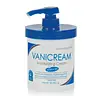What's inside
What's inside
 Key Ingredients
Key Ingredients

 Benefits
Benefits

 Concerns
Concerns

 Ingredients Side-by-side
Ingredients Side-by-side

Dimethicone 3%
EmollientPetrolatum 30%
EmollientWater
Skin ConditioningGlycerin
HumectantGlyceryl Stearate
EmollientDistearyldimonium Chloride
Aloe Barbadensis Leaf Juice
Skin ConditioningPolyethylene
AbrasiveStearyl Alcohol
EmollientCetearyl Alcohol
EmollientBehentrimonium Methosulfate
Methyl Gluceth-20
HumectantSteareth-2
EmulsifyingSteareth-21
CleansingAllantoin
Skin ConditioningCetyl Alcohol
EmollientTocopheryl Acetate
AntioxidantButyrospermum Parkii Butter Extract
Skin ConditioningPEG-10 Phytosterol
EmulsifyingPolysorbate 60
EmulsifyingCeramide Ng
Skin ConditioningStearamidopropyl Pg-Dimonium Chloride Phosphate
Jojoba Esters
EmollientDMDM Hydantoin
PreservativeMagnesium Ascorbyl Phosphate
AntioxidantButylene Glycol
HumectantMethylparaben
PreservativePalmitoyl Hexapeptide-12
Skin ConditioningPropylene Glycol
HumectantHydrolyzed Jojoba Esters
Skin ConditioningPropylparaben
PreservativeEDTA
Potassium Hydroxide
BufferingTribehenin
EmollientC12-15 Alkyl Benzoate
AntimicrobialRetinyl Palmitate
Skin ConditioningDimethicone 3%, Petrolatum 30%, Water, Glycerin, Glyceryl Stearate, Distearyldimonium Chloride, Aloe Barbadensis Leaf Juice, Polyethylene, Stearyl Alcohol, Cetearyl Alcohol, Behentrimonium Methosulfate, Methyl Gluceth-20, Steareth-2, Steareth-21, Allantoin, Cetyl Alcohol, Tocopheryl Acetate, Butyrospermum Parkii Butter Extract, PEG-10 Phytosterol, Polysorbate 60, Ceramide Ng, Stearamidopropyl Pg-Dimonium Chloride Phosphate, Jojoba Esters, DMDM Hydantoin, Magnesium Ascorbyl Phosphate, Butylene Glycol, Methylparaben, Palmitoyl Hexapeptide-12, Propylene Glycol, Hydrolyzed Jojoba Esters, Propylparaben, EDTA, Potassium Hydroxide, Tribehenin, C12-15 Alkyl Benzoate, Retinyl Palmitate
 Reviews
Reviews

Ingredients Explained
These ingredients are found in both products.
Ingredients higher up in an ingredient list are typically present in a larger amount.
Cetearyl alcohol is a mixture of two fatty alcohols: cetyl alcohol and stearyl alcohol. It is mainly used as an emulsifier. Emulsifiers help prevent the separation of oils and products. Due to its composition, it can also be used to thicken a product or help create foam.
Cetearyl alcohol is an emollient. Emollients help soothe and hydrate the skin by trapping moisture.
Studies show Cetearyl alcohol is non-toxic and non-irritating. The FDA allows products labeled "alcohol-free" to have fatty alcohols.
This ingredient is usually derived from plant oils such as palm, vegetable, or coconut oils. There is debate on whether this ingredient will cause acne.
Due to the fatty acid base, this ingredient may not be Malassezia folliculitis safe.
Learn more about Cetearyl AlcoholGlyceryl Stearate is a mix of glycerin and stearic acid.
It is used to stabilize the mixing of water and oil ingredients. By preventing these ingredients from separating, it can help elongate shelf life. It can also help thicken the product's texture.
As an emollient, it helps soften skin and supports barrier-replenishing ingredients.
In cosmetics, Glyceryl Stearate is often made from vegetable oils or synthetically produced.
This ingredient may not be fungal-acne safe
Fun fact: The human body also creates Glyceryl Stearate naturally.
Learn more about Glyceryl StearatePetrolatum is more commonly known as petroleum jelly. It is created by mixing waxes and mineral oils.
This ingredient is effective at reducing water loss by 99%. This is because it is an occlusive. Occlusives create a hydrophobic barrier on the skin to prevent evaporation. This property makes it great for hydrating dry skin.
Pro tip: Use occlusives, such as this ingredient, on damp skin for the best results.
The quality or origin of petrolatum is only known when disclosed by the brand. Most cosmetic petrolatum has gone through several purification stages.
Another benefit of occlusives is it protects your skin against infection or allergies.
Petrolatum may not be safe for fungal-acne. Studies show mineral oil / petroleum leads to the growth of M. Furfur, a type of yeast.
Learn more about PetrolatumPropylene Glycol is an odorless, colorless liquid. As a humectant, it helps skin retain moisture. It also aids in delivering active ingredients.
Another role of this ingredient is preventing a product from melting or freezing. Propylene glycol also adds antimicrobrial properties to a product, elongating product lifespan.
This ingredient is considered an organic alcohol and commonly added into both cosmetics and foods.
Those with sensitive skin or conditions may develop a rash when using this ingredient.
Learn more about Propylene GlycolWater. It's the most common cosmetic ingredient of all. You'll usually see it at the top of ingredient lists, meaning that it makes up the largest part of the product.
So why is it so popular? Water most often acts as a solvent - this means that it helps dissolve other ingredients into the formulation.
You'll also recognize water as that liquid we all need to stay alive. If you see this, drink a glass of water. Stay hydrated!
Learn more about Water